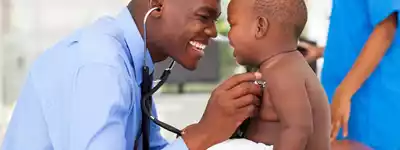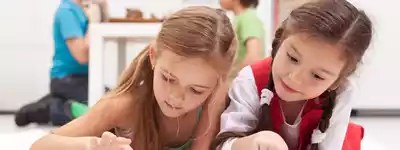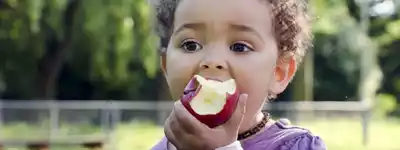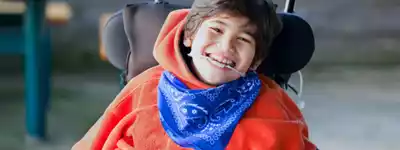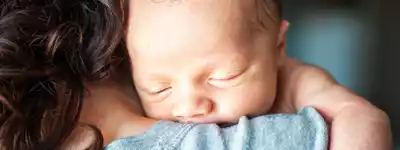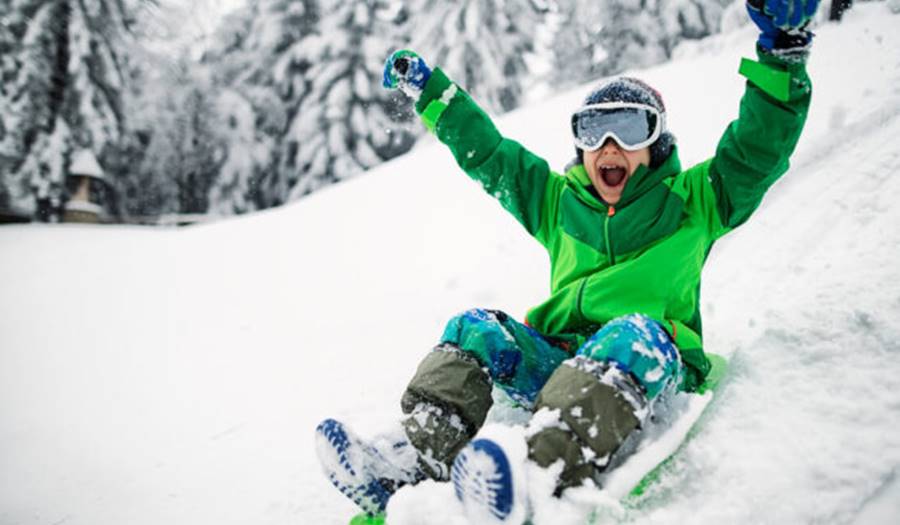
Winter Outdoor Safety
12/21/2020
Safety tips for outdoor sports and play
Winter is arriving here in New England. For some that means bundling up, starting a fire, and reading or playing board games together. And for other families, this means it’s time to get outside and play! Winter provides snow and ice allowing our children to play in the snow, ski, snowboard, skate and go sledding. These are all fun family activities and great ways to get exercise. We need to make sure we learn how to help our child stay warm and safe during their outdoor play.

COLD WEATHER FUN
Cold weather allows for fun winter activities, but it can also be dangerous for our bodies. It can be especially dangerous for children. They lose heat more quickly than adults due to their small body size. They are also less likely to come inside once they are feeling cold hoping to prolong the fun they are having!
We recommend not playing or doing activities outdoors if it is less than -15 degrees Fahrenheit. At this point skin can very easily freeze. At higher temperatures, we recommend taking frequent breaks to go inside and warm up. We also do not realize how much we sweat during outdoor activities. Breaks can be helpful to encourage fluid intake to ensure proper hydration.
Your child should be dressed in multiple light layers with insulated boots, mittens or gloves, and a hat. Babies and toddlers should have on a layer more than what an adult would be comfortable and warm wearing in the current weather. If their clothing gets wet while playing outside, make sure they change into dry clothes right away.
Small children should not have scarves or strings than can easily get caught and pose a strangling hazard. Also remember that children should not be in a car seat with a heavy or bulky coat as this can make the straps too lose to prevent injury in an accident.
Also, if you have a fire going such as a fire pit outside or a bonfire, watch small children closely. Consider a protective gate. And like having a water watcher to prevent drowning, it is smart to have a person who is 100% on duty watching your child around the fire Also be careful of hot beverages such as hot chocolate which can cause burns if spilled or if a child drinks it before it cools down.
And don’t forget about sun protection just because it is cold. Sun glare off of snow or ice intensifies the effects of the suns damaging rays. Make sure you apply sunscreen frequently and use goggles with tinted lenses or a UV shield.
Frostbite
Frostbite is when skin starts to freeze. It is more likely to happen to fingers, toes, ears, or noses. It often begins with a burning sensation that then turns to numbness. The skin may turn white, gray or may blister. The skin will have a waxy appearance.
If your child’s skin looks like it is at risk for frostbite or they may have frostbite it essential to gently warm up their skin. Bring them indoors and make sure they are in dry warm clothes. Cover them in blankets and provide a warm drink. Do not apply anything hot directly to the skin. Do not rub the skin or break any blisters. You can place their fingers or toes in warm (not hot) water for 20-30 minutes. For body parts that cannot be soaked, you can use a wet warm washcloth. If the skin does not start improving in color or appearance within a few minutes, please call us immediately.
Hypothermia
Hypothermia is when your body temperature drops below normal. A child with hypothermia will start with full body shivering and may act sluggish, tired, or clumsy. They may even slur words. Hypothermia is a medical emergency. Please call 911. While waiting for emergency help wrap them in a warm blanket or clothing, cover their core body areas (head and trunk), and make sure they get indoors if possible.

WINTER SPORTS
SKIING AND SNOWBOARDING
Skiing and Snowboarding are two great winter family activities. In our area of New England, we are lucky to have access to great mountains both locally and throughout Maine, New Hampshire, and Vermont.
What age is the right age to start these sports? We recommend skiing can start as young as 4 with a qualified instructor. We do NOT recommend snowboarding start until age 7. The key to learning to ski or snowboard is learning to control the skis or snowboard, learning proper skills such as how to stop, being aware of others, falling for safety, and learning how to adjust for different snow or ice conditions.
To help keep your child safe during skiing, make sure they are wearing the proper gear. Proper gear includes properly adjusted bindings, helmet specifically for skiing or snowboarding, eye protection, and sun protection. They should also be dressed in multiple thin layers and wind protection.
Plan frequent snack and water breaks as well as rest breaks. Muscle fatigue increases the risk of injuries. Make sure your child never skis or snowboards alone. Your child should stay on hills or trails and lifts that are appropriate for their level. If they find themselves on a trail or hill that is too difficult, they should remove their equipment and side-step down the hill.
Your child should also be familiar with the “Rules of the Slope” from the National Ski Area Association. These rules include:
• You must be in control of your skis or snowboards at all times.
• You must be able to stop or avoid people or objects
• People ahead have the right of way, you must avoid them
• Do not stop where you cannot be seen from above or where you obstruct the trail
• Use proper devices to prevent runaway equipment
• Observe all posted signs and warnings. Stay off closed trails
• Be able to use lift properly before getting on. This mean having the knowledge and ability of how to get on and off properly and safely.
Despite every safety precautions, ski and snowboarding injuries still occur. The CDC reports that snowboarding results in 25 % of all sports related injuries seen in the Emergency Room in winter. The most common injuries are sprains or broken bones. For snowboarders, the most common injury is wrist fractures due to the way children often brace their fall with their arm. In skiing, most injuries are sprains or breaks in legs due to bindings not releasing correctly. Over 35% of these injuries are ACL tears. Head injuries are also common. Helmets do not prevent all injuries and concussions are still common.

SLEDDING
A run down a hill on a sled is thrilling for both children and adults. But sledding can be dangerous. Over 52,000 injuries are seen every year in Emergency Rooms due to sledding. To help keep your child safe:
• Do not sled near cars or roads
• Sledding hills or trails should not have trees, fences, or large rocks
• Make sure the slope is not too steep or icy
• The end of the hill or trail should have a long flat area
• CHILDREN SHOULD BE WEARING A HELMET
• Always supervise children when they are sledding
• Stay away from large crowds
• Keep smaller children away from older children who are sledding
• Children should only sled feet first or sitting up
• Steerable sleds are preferred
• Sleds should be free of sharp edges or splinters
• Teach your child to roll off the sled if it won’t stop or there is danger ahead (such as a tree or another person)

SKATING
Skating is a fun family activity or one your child may enjoy with their friends. It can include rink skating, hockey, and pond hockey. With any skating on open water, you must ensure the ice if thick enough. This should not be done on your own but by calling your local police or fire department or even your local recreation department to see what bodies of water are approved. Whether skating on a rink or body of water, make sure your child knows to skate in the direction of the crowd, they know not to dart suddenly off or on the ice, and they should not eat or drink while skating. Children should also wear a helmet skating. For new skaters consider elbow or knee pads or a skating trainer to help reduce injuries from falling.
SNOWMOBILES
Snowmobiling is fun winter activity that is gaining popularity. There are lots of trails throughout Maine, New Hampshire and Vermont for families to enjoy. Snowmobiles should only be operated by children over 16 years of age and no child under the age of 6 should ride on a snowmobile. The operator should stick to marked trails, travel at a safe speed, and NEVER snowmobile at night. An operator should also never be under the influence of alcohol, illicit drugs, or sedating medications. Do not pull sleds or skiers behind a snowmobile. And everyone who is on or operating the snowmobile should have goggles and a helmet.
OUTDOOR SPORTS SAFETY GEAR
HELMET
Helmets need to be SPORTS SPECIFIC. A bike helmet is not appropriate to be worn skiing.
Your ski or snowboard helmet should be professional fitted at a ski center. Your child’s goggles should be tried on at the same time to ensure a proper fit with both pieces of equipment.
For sledding a ski or snowboard helmet is preferred but a bike helmet is acceptable
For ice skating, a ski, snowboard or bike helmet is acceptable. A hockey specific helmet should be used during any hockey games.
EYE GOGGLES
Goggles provide eye protection from snow or sleet. They also help reduce the glare from snow and ice to help improve visibility on the slopes. They also help protect your eyes from the sun and sun damage.
RUN AWAY EQUIPMENT PREVENTION
These items can include straps or leashes for poles or snowboards. Skis should also have breaks to help keep them from sliding down the mountain.
CLOTHING LAYERS
Clothing should be thin but layered. Layers should include:
- A base layer such as long underwear
- A light long on short sleeve T-shirt
- A fleece pullover or a front zip sweatshirt
- A Winter Jacket, waterproof if possible
- Lined pants or leggings
- Snow pants, bib style snow pants can be great for keeping snow out of clothing for younger children
- Wool socks
- Insulated Boots
- Wool Hat
- Insulated Gloves or Mittens
Winter activities are fun for children and adults alike. Make sure you have enjoyable experiences by following the above recommendations. By dressing properly and familiarizing yourself with safety precautions, you are ensuring a fun day for you and your children. Don’t’ forget the sunscreen!!!
Children’s Health Care of Newburyport, Massachusetts and Haverhill is a pediatric healthcare practice providing care for families across the North Shore, Merrimack Valley, southern New Hampshire, and the Seacoast regions. The Children’s Health Care team includes pediatricians and pediatric nurse practitioners who provide comprehensive pediatric health care for children, including newborns, toddlers, school aged children, adolescents, and young adults. Our child-centered and family-focused approach covers preventative and urgent care, immunizations, and specialist referrals. Our services include an on-site pediatric nutritionist, special needs care coordinator, and social workers. We also have walk-in appointments available at all of our locations for acute sick visits. Please visit chcmass.com where you will find information about our pediatric doctors, nurse practitioners, as well as our hours and services.
Disclaimer: this health information is for educational purposes only. You, the reader, assume full responsibility for how you choose to use it.


